A large number of different flies can be found on any farm over the summer months but relatively few are both common and annoying. The first step in dealing with a fly problem is to identify the kinds of flies present.
When the fly is identified, effective methods and materials can be selected that focus on the prevention and control of that species. Simple fly traps may be all that is needed in some cases. More complicated approaches may be necessary in other situations.
Most of the common pest flies are easy to identify simply by comparing a specimen with the illustrations provided below. Others are more non-descript and have to be keyed out by a specialist using technical keys.
1 Integrated pest management system that anticipates and prevents pests from reaching harmful levels by using all suitable techniques (e.g., natural enemies, cultural management, and the judicious use of pesticides).
Basic Biology Of Common Flies
Once you know which flies are present on your farm, you can learn about their basic biology. This will enable you to figure out the best means of controlling them and preventing them from becoming a problem in the future. |
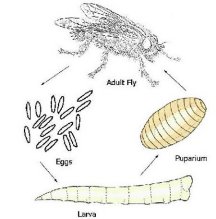
|
|
| Black Blow Flies2 Adult black blow flies are dark green or blue-black on the thorax and abdomen and about 8-9 mm long.
Black blow flies are one of the most common flies associated with wound myiasis, especially in livestock. In cases of myiasis, larvae sometimes cause a bloody discharge, indicating a certain amount of destruction of living tissue.
The larvae normally feed in dead tissue, breeding in carcasses and wounds but they are also common around household garbage cans. The larval stage takes 4-15 days. Growth from egg to adult takes 8-15 days.
The adult life span can range from 45-68 days. They are more common in the spring and fall and scarce in the summer. Cool weather favors development. These flies overwinter as adults. Adults emerge for brief periods throughout the winter. In warmer climates, breeding is continuous. |

|
| Black Flies3 Most black flies are about 2-5 mm long, black or grey coloured, short legged, stout, and the thorax is strongly convex, giving a humpbacked, gnat-like appearance.
Like mosquitoes, adult female black flies feed on blood and are often serious pests. Black flies often occur in enormous numbers in the spring and early summer months, close to clean, fast-moving rivers and streams where their larvae develop. They attack people, cattle, deer, birds, and other animals. Livestock can die if bitten by large numbers of black flies.
On people, they crawl into sleeves, under neckbands, around boot tops and other vulnerable places, especially favoring the head just beneath the rim of a hat. Bites can cause swelling and numb soreness for many days. On cattle and horses, the ears seem to be the favorite feeding location.
Flies lacerate the skin and suck blood. They have a strong anticoagulant in their saliva that facilitates bleeding of the host. A lesion may form at the bite and the bitten area itches.
Adult black flies are migratory, commonly flying many miles from larval breeding sites. Unlike mosquitoes, black flies are day-time feeders. During sunny, warm days, peak attacks occur in mid-morning and then have a more intense phase in evening, ending at dusk. However, biting greatly intensifies at the onset of storms and may persist all day when overcast conditions occur. |
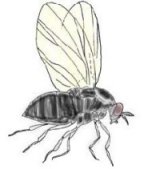
|
| Blue Blow Flies4 The adult blue blow flies have a dull-coloured thorax and a shiny metallic blue-green abdomen. They are about 8-9 mm long. The head is grey with large red eyes, black sides, and reddish beard. The thorax is dark grey. The legs are dark grey to black and bristly. The wings are clear.
Blue bottle flies breed almost exclusively in decaying animal matter. Female flies may lay hundreds of eggs during their lifetimes. The eggs require 90% relative humidity to hatch. If enough moisture is present, hatching occurs almost immediately.
The larvae grow rapidly and, when mature, often crawl many feet to pupate in drier places, either in the soil or in crevices of buildings. New adults emerge in 2-3 weeks. They can have several generations per season. They often overwinter in buildings. |
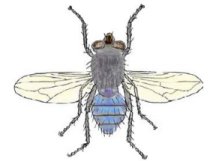
|
Cluster Flies5
Cluster flies closely resemble house flies, but they are usually larger (9.5-12.5 mm) and have a yellowish sheen on the thorax. With a mostly black body, their thoracic hairs are short, curly, and yellow to golden. They have tufts of crinkly yellow-orange hairs where their wings attach to the thorax. Older specimens may have some of the yellow thoracic hairs rubbed off. The wings often overlap at their tips when the fly is resting.
Cluster fly larvae are parasites of earthworms and breed outdoors in lawns and fields during the spring and summer. Earthworms are usually most abundant around places where manure has been piled or stored and are common in grassy areas where the soil is moist.
The large numbers of adults that emerge in late summer and early fall seek protected places to spend the winter. Often, as with face flies, this site is a structure. Inside a structure, the flies tend to "cluster" in large numbers at windows or on ceilings or other high places.
They often occur within the walls, attics and basements of homes. Window screens alone offer no protection from these flies because they crawl into the home through small openings in the walls of the building.
Their habits inside a home are similar to those described below for face flies. Both face flies and cluster flies may be attracted to the same structure year after year. Cluster flies are also bothersome in the spring when they try to escape from the home.
When crushed, they leave a greasy spot on upholstery, carpets, and painted surfaces and give off an odour like buckwheat honey. |
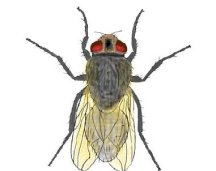
|
Deer Flies6
Tabanidae include both deer flies and horse flies (see below). Deer flies are smaller than horse flies (10-13 mm long). Their wings are tinted smoky brown or have dark patterns. Their thorax is greenish-yellow with dark stripes. The eyes touch each other on the top of the head in males and are separated in the females.
Deer flies are often serious pests of livestock and humans. They are often seen around swamps, marshes, and ponds. The males are found on flowers and feed on nectar and pollen. The females are usually seen circling your head.
The larvae of deer flies are aquatic and are mostly found in shallow water or moist soil along the edges of ponds, dug-outs, small streams, and cattail areas of some ditches. They feed on decaying organic matter. |
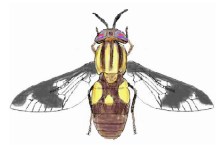
|
Dung Flies7
There are many kinds of dung flies but the most striking is the yellow dung fly. This bright yellow, hairy fly is about 9 mm in length. It has dark bristles on long slender legs.
Many kinds of dung flies breed in cow, horse, pig, and sheep dung. The larvae of some species live in decaying plant material and can be very abundant in rotting vegetation and mud along shorelines. Most of the small black flies that fly up if you disturb a fresh cow pat are dung flies. The common yellow dung fly is a typical example of this family and, although their larva feed on the dung, the adults are predatory and feed on other flies which have come to the dung to feed.
Swarms of the furry, golden males collect on steaming, fresh cowpats. The arrival of females is greeted with flurry of activity and mating pairs can be seen. The eggs are laid in dung. The females prefer fresh cowpats because older ones form a crust and it becomes very difficult for egg laying. As the pat gets older, therefore, fewer and fewer females arrive.
The larvae feed in the dung, eating organic matter and other smaller fly larvae. When they devour the larvae of common stable flies, the larvae destroy a pest that causes endless aggravation for cattle. The larvae of some species are found in damp soil where they prey on small invertebrates.
Although dung flies may resemble bees in appearance, they leave us and our animals alone. Considered beneficial insects, they are harmless to people, pets, and livestock. |
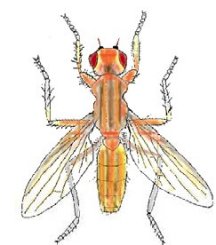 |
Face Flies8
These small (6-8 mm long), non-biting flies are greyish-brown in colour with 4 dark stripes on the thorax and a grey-black patterned abdomen. In the female, the abdomen has little yellow or orange on the sides but, in the male, the sides of are yellowish-orange to orange-brown.
The eyes of the female are surrounded by a silvery stripe; the male's eyes almost touch in the center. The mouthparts of the face fly are fleshy and blunt and do not protrude straight from the head like a bayonet, as do those of the horn fly and stable fly.
Face flies superficially look like house flies but they lay their eggs only on fresh cattle manure in fields. The life cycle takes about 2 weeks. The larvae develop within the dung and pupate in the surrounding soil.
Unlike the house fly, face flies are pests of cattle in pastures during the warm months. The adult female flies tend to feed on secretions from the eyes, nostrils, and mouths of pastured cattle, causing extreme annoyance and allowing for the transmission of pinkeye and other eye diseases.
By contrast, male face flies feed only on nectar and dung. They spend much of their time resting on branches and fences and attempting to catch and copulate with female flies as they move about.
Face flies are strong, robust fliers that can travel several miles. Unlike house flies, face flies do not enter darkened barns or stables during the summer months. However, in the fall, they will enter farm homes and other buildings and overwinter indoors near pastures or where cattle are kept. During warmer days in the early spring, some face flies may come out of their hiding places in the attic and walls and appear on south-facing windows. |

|
Flesh Flies9
Adult flesh flies are greyish with 3 black stripes running the length of the top surface of the thorax (just behind the head). They have a light and dark checkerboard pattern on the abdomen and are about 10-13 mm long.
Flesh flies are similar to blow flies in their biology. Most flesh flies near the home are attracted to odours of decay.
They breed in excrement, decaying vegetation, and animal flesh or meat. The female deposits live larvae on fresh animal carcasses and on dead snails and large insects.
Blow fly larvae and grasshopper nymphs are common hosts of flesh flies. There are recorded cases where females have deposited larvae into open wounds of animals, including humans, hence their names as flesh flies. The adult flies do not bite but feed on a wide range of liquid substances.
Most larvae infest wounds, carrion, or excrement. The larvae of some species of flesh flies are beneficial in that they prey on eggs, nymphs, or larvae of more harmful insects. |
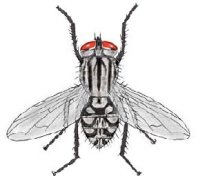 |
Green Bottle Flies10
The adult green bottle blow flies are shiny metallic green to bronze. Medium-sized, these stout flies are 7-14 mm long.
The thorax has 3 cross-grooves and black bristle-like hairs. The antennae and legs are black. The wings are clear with light brown veins.
Female green bottle flies lay up to 180 eggs on carrion, dead fish, manure, unprotected wounds, or garbage. The larvae attain full size in 2-10 days, drop to the soil, and burrow shallowly before pupating. There are up to 8 generations a year, the last overwintering as larvae in the soil.
The green bottle fly is not as attracted to the smell of fresh meat as is the blue bottle fly. It is also less likely to enter homes. It is often found near dog feces, manure, and garbage cans. |
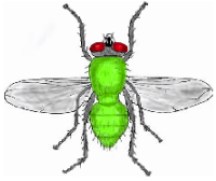 |
Horn Flies11
Adult horn flies are slender, 3.5-5 mm long and are about 1/2 the size of a typical housefly. They are charcoal gray in colour, with 2 dark stripes on the thorax, and a few diffuse spots on the top of the abdomen. They have an extended, piercing proboscis and long palps.
Horn fly adults typically occur on cattle farms but they may also attack sheep, goats, horses, mules and dogs on any farm. The flies spend most of their life on the host animal, usually congregating on the back and shoulders. During very hot or rainy weather, the flies move to the underside of the belly. Both sexes bite intermittently and may feed up to 20-40 times per day.
Large numbers of flies (more than 500 per animal) cause lower weight gains and milk yields. Animals become so annoyed that they may injure themselves while attempting to dislodge the flies. They do not bite people. Like stable flies, the mouthparts of horn flies are extended forwards from the head as a piercing proboscis.
Females require blood meals for egg production and can lay several hundred eggs during their lifespan. They leave the host briefly to lay eggs on very fresh, undisturbed cattle manure. The larvae are yellowish-white maggots. They complete their development in the pat within 1-2 weeks. The entire life cycle is completed within 2-4 weeks. Horn flies overwinter as puparia beneath cow pats and emerge the next spring as adults. |
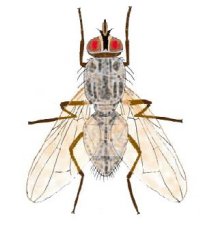 |
Horse Flies12
Horse flies are like deer flies but much larger and heavier-bodied (14-19 mm long). Their wings are clear and their thorax is usually brownish-grey striped.The abdomen may be orange and black patterned or similar to the colouration of the thorax.
As with deer flies, you may encounter these flies on farms nearby streams, dugouts, ponds, and lakes, where their larvae breed in decaying organic matter. Like the deer fly, the female horse flies lay their eggs in masses on vegetation overhanging water. The larvae are omnivorous, feeding on organic debris, other insects, tiny crustaceans, snails, earthworms, and other small organisms. Development from egg to adult requires 70 days to 2 years, depending on the species.
Female horse flies cut through the skin with knifelike mouthparts. They then feed on the blood that pools around the wound. The wound continues to bleed after the fly leaves and often attracts face flies.
On dairies and livestock farms, large numbers of these flies can cause extreme annoyance and fatigue, blood loss, reduced milk production, and reduced weight gain. Some species have also been implicated in the transmission of tularemia, anthrax, anaplasmosis, and leukosis. |
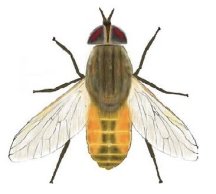 |
House Flies13
House flies are 4-8 mm in length and black with 4 dark stripes on thorax. The abdomen is greyish or yellowish at the sides and has a dark stripe down the middle. These flies have fleshy mouthparts. The eyes are reddish and are well separated in male. The eyes have a golden stripe around the outer edge.
The legs are hairy with adhesive pads and sharp claws. The wings are clear and are held level and straight back.
The house fly is probably the most common fly found on Manitoba farms. Most flies caught in houses are house flies. The house fly causes complaints on farms near sanitary landfills, poultry farms, dairies, or other sources of rotting organic matter of plant or animal origin that attract egg-laying females.
House flies have been implicated in the spread of over 30 bacterial and protozoan diseases. Fortunately, house flies do not transmit many of these diseases with great frequency. Because they can transmit many serious diseases, house flies are considered to be a greater threat to human health than most other insects.
The female lays her batch of eggs (75-150 eggs) on wet, decaying organic matter lying in the open (e.g., on wet garbage, animal manure, spilled feed, bedding, decaying fruit, compost piles, rotting plant debris, landfills). She can lay 4-6 batches in a lifetime.
These eggs usually hatch within 24 hours into tiny, creamy-white maggots that feed in the waste. Mature maggots migrate away from their food sources in search of suitable sites for pupation. They change into the pupal stage from which the adult flies emerge. It takes about 2 weeks for a fly to go from the egg to adult stage. Males live for 2 weeks and females up to 3.5 weeks.
Adults feed on a wide range of materials, including feces, garbage, fresh and decaying fruit, and most human food. Adult flies are very strong fliers. |
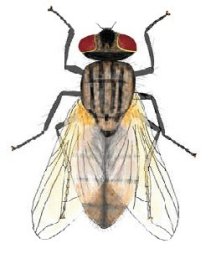 |
Stable Flies14
Stable flies resemble house flies with their dull appearance and their 4 dark stripes on the upper body. These flies are 5-8 mm long. The abdomen has dark spots. "Checkerboard" markings are obvious on the underside of the abdomen. Stable flies have a needle like, stiff, piercing mouthpart that is folded below their head.
Both sexes feed on the blood of warm-blooded animals (including people, dogs, and horses). They are often a pest on farms that have cattle in pastures and feedlots. They often bite through clothing, especially on the ankles. Dogs that are kept outdoors can be tormented and severely bitten. Adults do not feed at night.
Females lay 40-80 eggs per batch and 10-12 batches in a lifetime. Larvae can develop in urine-soaked straw, chicken manure, compost piles, wet hay bales, and grass clippings.
The stable fly also breeds in vegetation strewn along the shorelines of lakes and bays and in accumulations of wet grass clippings from yards and golf courses.
Maggots burrow into the breeding material, following moisture inward as the substrate dries. Under favorable conditions, the entire egg to adult life cycle is from 21-25 days. This can be as long as 78 days in unfavorable conditions or in cool climates. Before pupation, the mature larva crawls to drier parts of the medium. Stable flies overwinter as larvae or pupae.
Stable flies can move great distances. This often occurs when they are picked up by weather fronts and carried aloft for several hundred miles. Uninfested areas thus can become heavily infested almost overnight. |
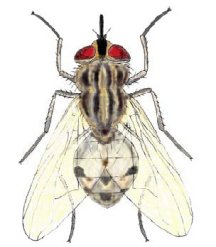 |
|
Fly Prevention And Control
Flies can be controlled without using insecticides, except when large numbers of adult flies have already inundated a farm site. Fly control is more effective in the long-term if sanitation and prevention are the basis of the control program. The non-chemical alternatives include the use of special fly traps, physical control, and exclusion.
Prevention Through Sanitation
It sounds simple but sanitation is still the most effective and important way to control flies. All outside trash areas must be kept clean. Garbage should be drained and wrapped in plastic bags before being placed in trash receptacles outdoors. |
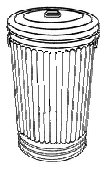 |
Use garbage cans with tight fitting lids, lined inside with plastic bags. By placing garbage in secure plastic bags, odours will be reduced, therefore attracting fewer egg-laying flies. Periodically, food residues should be washed from garbage containers. The best time to clean garbage cans is in the early summer. Locate the garbage cans as far away from the farm house or building as possible. Dispose of garbage weekly at a regular landfill or by incineration.
Eliminate potential breeding materials (e.g., rotting straw bales, loose straw, or mulch, leaves, manure, garbage, and animal excrement). Compost piles can be covered with black plastic that will heat the organic matter, destroying fly larvae. Wooden compost boxes can be painted dark-brown or green to blend in and absorb heat. |
|
Household and livestock-related garbage, dumped at the local landfill, can quickly generate large numbers of flies, especially when the garbage already contains fly eggs, larvae, or pupae. Landfill workers must be aware of this possibility and compact and cover such garbage at least twice weekly.
Occasionally, wet farm garbage (e.g., wet, spoiled grain; wet, waste from calf pens) that is brought to the landfill is loaded with fly maggots and pupae. Landfill workers should be alert to this and immediately compact and cover such material. Thousands of adult flies may emerge from such garbage within a few hours.
Avoid moist pet foods left outdoors for several days. Remove fallen, fermenting, or over-ripe fruits from the ground. Any potential breeding material should be spread thinly in the field and allowed to dry to prevent fly development.
Dispose of animal carcasses (including livestock, pigs, and poultry). Collected carcasses must be removed quickly during the summer. Otherwise, they will quickly become "fly factories" within 24-48 hours. Dead livestock can be quickly and conveniently removed by calling Rothsay (Maple Leaf Foods) in Winnipeg at (204) 233-7347.
Road kills are another source of flies. A small animal (e.g., dead cat, ground squirrel, tree squirrel, rabbit, or porcupine) can easily produce more than a thousand blow flies if left by the side of the road. Dead deer, left to rot in a ditch, can yield tens of thousands of flies. You should report such problems to Manitoba Highways and ensure that the carcass is promptly removed.
Prevention Through Exclusion
Flies seem to be able to find their way into homes, garages, shops, and bins through the smallest of overlooked entrances. Even when all windows have good screens, when all doors have screened storm doors, and when all known cracks and crevices have been filled with caulking, the odd fly seems to get inside the home. Just everyday coming and going through the back door allows agile flies to get inside the home.
Sometimes, they are able to find their way into attics and, from there, into the home proper through various vents and electrical outlets. Nevertheless, careful attention to blocking all of their normal entrances to a building should reduce their numbers inside to a more tolerable level.
Screen doors should open outward and have fitted springs for tight closing. Because flies are quick at entering opened doors, a double set of doors is best where adult fly populations are really heavy.
Manure Management
Solid animal wastes (e.g., those produced in buildings, corrals, or pens) can be collected and composted until such time as they can be spread thinly on fields. Clean cattle pens, drainage areas, loafing sheds, stalls, feeding aprons, spilled feed, pet droppings, and other decaying organic matter at 10-day intervals to minimize fly breeding.
Liquid wastes can be pumped from holding pits, in the spring or fall, to be spread over or injected into fields.
The right time to spread manure is in the spring, as soon as the fields are dry enough to travel on with spreading equipment. In the fall, after harvest is complete, is the second best time. There is little chance of any fly larvae completing their development after mid-September.
During both periods, weather conditions are usually cool with overnight frosts, reducing both nutrient loss and odour problems, especially when the manure is immediately incorporated into the soil.
Control With Fly Swatters And Tapes
A simple fly swatter or folded newspaper is effective indoors against a few individual flies. Rolls of sticky fly paper are available from most hardware stores. Use the tapes on porches and in garages and storage sheds where aesthetics are not important.
Control With Vacuuming
Flies found inside in the fall may also be removed with a vacuum. Because flies are drawn to light, attract them to a bright window in an otherwise darkened room, making it easier to vacuum them. This method is especially useful in cluster fly control.
Control With Electric Light Traps
Electric light traps are available commercially to control house flies in homes. Some are designed to be unobtrusive, blending in with the décor. They are ineffective outdoors. For farm buildings, including livestock facilities, utilitarian models are available in a wide range of sizes. These types of traps are generally fairly expensive but worthwhile where sanitation is a vital concern. |
Control With Baited Jug Traps
Some jug, bag, and jar traps use bait and water to attract and capture flies. These are especially effective against the various kinds of blow flies. Several types and brands are available but one of the most popular is the Fly Terminator, a 4 L trap that uses an attractant in water (and the odour of dead flies) to draw in the flies. It has an effective attracting radius of about 35-50 m. The larger size is available from local feed mills (e.g., Manitou Feed-Rite). The smaller disposable traps are usually available from most local True Valu and Co-op lumber and hardware stores.
Trap placement is important. If the farm yard has a small or moderate fly problem, traps placed close to the home can attract flies from all over the area and make the problem worse.
It is better to set the traps close to fly breeding sites with any prevailing breeze blowing from the trap toward the breeding area. Place traps well away from outdoor areas that are used for eating or recreation. |
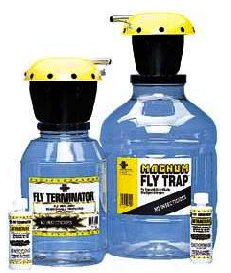 |
Control With Sticky Fly Traps
Old-fashioned, sticky fly coils, some with and some without fly attractants, can be hung in garages, screened decks or porches where the occasional fly gets in through an open screen door or pet entrance.
Considered by most people to be too unsightly for use inside the modern farm home, the fact remains that they are relatively cheap and very effective fly catchers. They seem to be most effective against house flies because these flies tend to rest on hanging vertical surfaces more than most other kinds of flies. |
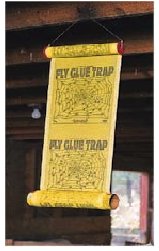 |
Control With Horse Fly Traps
The Manitoba or black ball horse fly trap is essentially a pyramid-shaped tent raised about three feet off the ground with a large, black-painted beach ball hanging underneath. For some reason, horse flies are attracted to a large, black ball. When they discover the ball is not a source of food, they fly up and away. They are then caught within the tent and continue to crawl or fly upwards. At the top is a plastic jar that looks and acts like a minnow trap to capture the horse flies. Some people just cover the heat-absorbing ball with Tanglefoot and hang it so the sticky ball cannot contact anything. Where horse flies are a severe problem, several traps may be needed to significantly reduce biting.
Commercial versions, like the one shown below, are available.15
Horse and deer flies use trees and bushes for resting sites, and tend to fly along the edges of woods. Placing the trap in the middle of narrowed areas between buildings will catch flies flying across those 'shortcuts". Other good areas to set up the trap are next to dug-outs, shelterbelts, and livestock pens or barns. Many traps have been design to catch specific groups of flies. |
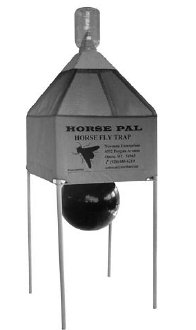 |
|
Control Using Biocontrol Agents
A fly's natural enemies include predators, parasites, and pathogens. Although some of these organisms are commercially available from the U.S.A., special permits must be obtained from Agriculture Canada to import most of them into Canada. Sometimes, Canadian sources advertise in farm weekly newspapers. Some success has been reported in using fly parasites, chickens, and ducks for fly control on livestock farms.
Because widespread spraying with insecticides for fly control kills natural enemies, every effort should be made to prevent fly problems and, if they still occur, to use non-chemical methods of fly control.
Personal Protection From Biting Flies
Biting fly control (including black flies, stable flies, and mosquitoes) is difficult due to the migratory adult stage and their extensive breeding habitats. In terms of personal protection, choice of clothing can be important. Biting flies are highly attracted to dark colours, so wear light coloured clothing. A hat, long-sleeved shirts, and pants are also important. Proper clothing, plus the use of insect repellent on exposed skin, will minimize bites from these insects.
Chemical Fly Control
Total reliance on insecticide applications in and around the house often results in failure to produce long-term control results. Constant effort must be made to eliminate and dry out potential fly breeding sites. At times, insecticides may be helpful in reducing heavy nuisance fly populations.
Insecticides For Fly Control Outside The Home
Treat outdoor surfaces where flies rest, especially around doors, windows, screens, gables, garbage cans and trash piles with a residual spray of a Health Canada-approved, labelled insecticide.
There are many insecticide formulations labelled for fly control. Some emulsifiable concentrate formulations of dichlorvos, dimethoate, methoxychlor, and permethrin can be used outside as residual sprays. See the opposite table for other formulations. Remember, before using any insecticide, always read and follow label directions and safety precautions (the label is the law).
In some cases, heavy fly populations are best controlled by a licensed pesticide applicator or professional pest control firm. Homeowners often do not have the experience, cannot obtain certain insecticides or do not have the proper equipment needed to perform the control job effectively.16
Some of the more commonly used insecticides, available for fly control in the yard and on the outside of the buildings, are listed in the table below. In addition, there are dozens of different ready-to-use sprays available at local stores.
Whichever product is purchased, ensure that it can be used where flies are a problem on your farm. Something that might be appropriate in a dairy barn might not be suitable for use around the home. Carefully follow all label directions and precautions.
| Insecticide |
Treatment |
| Fly Strips |
| Dichlorvos 20% Resin Strip |
Suspend 1 insect strip per 30 m3 of air space. |
| Scatter Baits |
| Dibrom |
Mix wet or dry bait using sugar as an attractant. Follow label instructions. |
| Dylox |
Scatter 1% bait using 125 g bait per 100 m2. |
| Premium Golden Malrin |
Scatter 125 g of 1% bait per 50-100 m2 to areas where flies congregate. |
| Residual Wall Sprays |
| Permethrin |
Use 0.5% spray. |
| Cygon |
Mix 2.5 L 4E per 100 L water. Apply 5 L mixture/50-100 m2 . |
| Dylox |
Mix 160 g 80% SP in 100 L water and apply 5 L mixture per 50 m2 . |
| Space Sprays |
| Dibrom |
Use 3 mL Dibrom in 1 L water and apply as a space spray. |
| Pyrethrins |
Apply ready-to-use mixtures as a mist or space spray or from automatic dispensers. |
| Dibrom |
Apply by aircraft or mist blower according to label directions. |
Insecticides For Fly Control Inside The Home
To kill the annoying flies that buzz about rooms, you can use a synergized pyrethrins spray or aerosol. You will obtain best results with pyrethrins if the room is closed and the spray or aerosol is misted into the air. Other products (containing allethrin, permethrin, phenothrin, resmethrin, sumithrin or tetramethrin) are also available. All of these products are "quick kill" insecticides and have little or no residual action. |
After using a spray indoors, leave the room and wait until the odour of the insecticide disappears before using the room again.
Cluster flies, face flies and blow flies are difficult to control once they have gained access to homes because they hibernate in wall voids and other inaccessible places. If there is a severe infestation, you could use a 2- or 3-gallon compressed air sprayer to apply a 3% Malathion residual spray to surfaces in attics, basements, closets, store rooms, and other areas where the flies congregate. |
 |
You could also inject diazinon or bendiocarb dust into window pulley openings and, wherever possible, into wall voids and other confined spaces where the flies may be hibernating.
Resin strips containing dichlorvos may be hung in areas containing these flies if there is little or no air movement. Use one 10-inch strip per 1,000 cubic feet of space. |
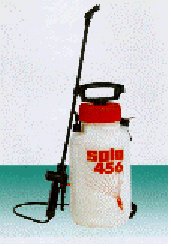 |
These strips are effective up to about three months but only if they are placed in the same "chamber" as the flies. Note that piles of dead flies left in the attic can sometimes lead to secondary infestations of carpet or larder beetles and rodents. |
 |
|
Rotate Insecticide Use
Flies are becoming increasingly difficult to control with many insecticides, especially inside farm buildings. The interiors of such buildings are like small islands. A few flies unaffected by a given insecticide quickly generate a whole population of flies resistant to that insecticide or, in some cases, to the class of insecticides to which the product used belongs.
If flies are a perennial problem around a farm-site, it is good practice to rotate insecticide use. For example, with cluster flies, the exterior of a building might be treated first with a synthetic pyrethroid (e.g., permethrin) and later with an organophosphate insecticide (e.g., dichlorvos).
Section II - Mosquito Prevention |
Mosquitoes are actually small, slender flies that have long thin legs and a long and sharp proboscis. The males have feathery antennae and the females have sparsely haired antennae. Only the females are blood feeders. The males feed on nectar. Of the human diseases that are known to be transmitted by mosquitoes, western encephalitis is the most important in Manitoba.
The larvae are aquatic and occur in small ponds, pools, ditches, tree holes, and in water-filled artificial containers. The larvae feed on algae and organic debris. |
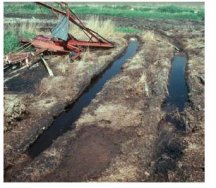 |
The adults are common near water and are usually most active at sunset, during the night, or when calm, cloudy, humid conditions prevail. The life cycle of the mosquito is similar to that of the fly, except that the non-adult stages are aquatic.
Eggs are laid on the surface of the water or the edges of dried up or stagnant pools of water. The larvae go through four actively feeding larval instars before turning into non-feeding pupae. The adult emerges from the pupa after 2-3 days. In Manitoba, larvae require between 5 days and 4 weeks to mature, depending on water temperature and species. |
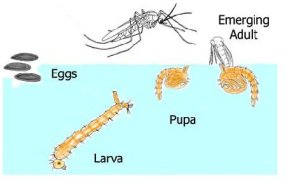
|
The fresh adults emerge a few days later. Under ideal conditions, mosquitoes can go from eggs to adults in 6 or 7 days.
A few days after emerging, adult females are ready to feed and mate. A blood meal is usually required before females can lay eggs and repeat the life cycle. Each female lays batches of about 100 eggs. The eggs of many of our nuisance species are drought resistant and can remain viable for several years. Some mosquitoes produce several generations per year but most complete only one or two. Some mosquitoes pass the winter as fertilized adults whereas others overwinter as eggs or larvae. |
 |
|
Mosquito Prevention
| Mosquito Sources |
How to Reduce Farm Mosquitoes |
| Ornamental Ponds |
Stock with fish; remove excess vegetation |
| Swimming Pools |
Keep water off cover; maintain water quality at all times |
| Tree Holes |
Fill hole with sand or mortar |
| Plastic Wading Pools |
Drain water when not in use, turn upside down, or cover so mosquitoes cannot lay eggs |
| Small Containers |
Empty water; store in an inverted position; dispose of; or cover |
| Bird Baths |
Change water at least once a week |
| Standing Water |
Eliminate by draining; fill in low areas |
| Watering Troughs |
Stock with fish or change the water weekly |
| Roof Gutters |
Clean every fall to remove leaf debris |
| Irrigated Lawns |
Avoid over-irrigation; drain standing water |
| Rain Barrels |
Screen the top or treat with detergent weekly |
| Garbage Cans |
Drill drainage holes, drain any water present; keep covered |
| Boats |
Remove drain plug and tilt when storing |
| Canoes |
Store on a rack, upside down |
| Wheelbarrows |
Store upside down |
| Old Tires |
Take to recycling centre; drill drainage holes in tires used on swings |
| Tarps |
Ensure there are no depressions that collect water |
| Roadside Ditches |
Mow tall grass and weeds to minimize mosquitoes using them as resting areas |
|
Personal Protection
Personal protection may be achieved with clothing and repellents. Mosquitoes are highly attracted to dark colors, so wear light colored clothing. A hat, long-sleeved shirt, and pants are also important.17 Proper clothing, plus the use of an insect repellent containing DEET on exposed skin, will minimize bites from these insects.
Screens
Just as window and door screens are a necessity for flies, the same holds true for mosquitoes. Keep all screens in place and in good repair. |
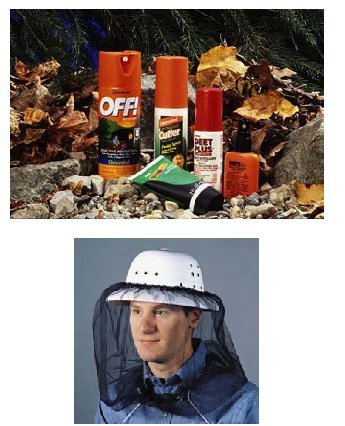 |
|
Controlling Larval Mosquitoes With Insecticides
Although the best way to control mosquito larvae is through draining and filling low areas that form stagnant pools of water and by ensuring water is not allowed to collect in artificial containers, it may sometimes be necessary to treat larval breeding sites with an approved mosquito larvicide.
Only a few products are available for domestic use. The most common product used on the farm is Malathion 50EC, widely available at most local chemical sales outlets. It can be used as directed on the label to treat mosquito-breeding sites wholly confined to your farm property. A more environmentally acceptable product is BTK, a bacterial formulation that is specific to mosquitoes. Products available to the farmer include domestic formulations of Aquabac 200G18 and Vectobac 200G19.
Controlling Adult Mosquitoes With Insecticides
Insecticides for mosquito control in and around the house can only give temporary relief. A constant effort must be made to eliminate potential larval mosquito breeding sites. But, even if you eliminate all possible breeding sites on your personal property, mosquitoes from other areas will still fly to your part of the world. In such cases, insecticides may provide some relief. |
Controlling Mosquitoes Indoors
If you have an indoor mosquito problem, you can use a space spray to kill them. This can be done with a hand-held, synergized pyrethrin aerosol spray. Other products (containing allethrin, permethrin, phenothrin, resmethrin, sumithrin or tetramethrin) are also available. All of these products are "quick kill" insecticides and have little or no residual action.
After using a spray indoors, follow all label precautions and be aware that some people, pets, and plants may be sensitive to the spray. After spraying, leave the room and wait until the odour of the insecticide disappears before using the room again. |
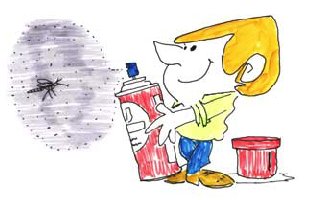 |
|
Controlling Mosquitoes Outdoors
Mosquitoes can be controlled outdoors with either the old-fashioned thermal fogger (above) or the new, more effective, cold foggers (bottom).
Canadian sources of this equipment include Pestalto Environmental Products, Viceroy Distributors20, and M.K. Rittenhouse & Sons.21
Foggers give quick knockdown and kill but have no residual effect. Malathion 50EC can be used in thermal foggers.
Several products (including those containing pyrethrin, resmethrin, or malathion) are available for cold foggers. Your local chemical sales outlet can order in products for cold fogging.
For greatest effectiveness with foggers, treat the area in the evening when mosquitoes are most active and when weather conditions are most suitable (i.e., low winds, warm temperatures, higher humidities).
Residual spraying is the other option. In many cases, you will find mosquitoes resting on or in certain shrubs, small trees, ground cover and other such vegetation. Residual sprays are an excellent choice to use in this case, giving several days of control. Products available include Malathion 50 EC, Methoxychlor 240 EC, and Permethrin 500 EC.
Residual sprays leave a long-lasting residual deposit on the vegetation. When treating for mosquitoes, lightly spray top and bottom surfaces of foliage. The best time to treat vegetation is early morning or late evening when wind speeds are less than 10 km/h.
|
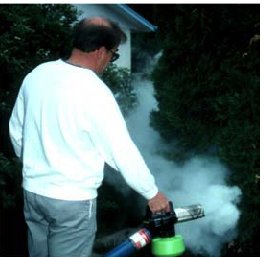 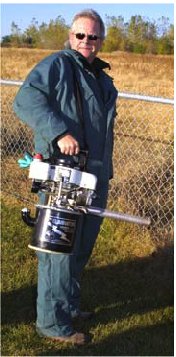 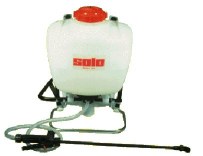 |
|
Acknowledgements
This report is a Covering New Ground Project, sponsored by Manitoba Agriculture and Food. The author, Dr. Roy Ellis (Prairie Pest Management) thanks Dr. T. Galloway and Dr. R. Roughley of the University of Manitoba Entomology Department, R. Gadawski of the City of Winnipeg Insect Control Branch, and L. Manaigre, J. Gavloski and B. Elliott of Manitoba Agriculture and Food Soils and Crops Branch for providing specimens, technical information, and/or advice. All drawings are copyright of the author. Disclaimer
This report contains advice and insecticide recommendations that are subject to change at any time. These recommendations are provided only as a guide. It is always the insecticide user's legal responsibility to read and follow all current label mixing directions and precautions for the specific insecticide being used. Because of constantly changing product labels and product registrations, some of the recommendations that are given in this report may no longer be legal by the time you read them. If any information in these recommendations disagrees with the label, the recommendation herein must be disregarded. No endorsement is intended for products mentioned, nor is criticism meant for products not mentioned. The author and the sponsoring organization assume no liability resulting from the use of these recommendations.
Suggested Citation: Ellis, R.A., 2002. Mosquito and Fly Prevention and Control on Manitoba Farms. Manitoba Agriculture, Food and Rural Initiatives, Soils and Crops Branch, Unpublished Report, 16 p.
2 Family: Calliphoridae; Species: Phormia regina 3Family: Simuliidae; ex, Simulium sp. 4 Family: Calliphoridae; Species: Calliphora vomitoria and Calliphora vicina 5 Family: Calliphoridae; Species: Pollenia rudis 6Family: Tabanidae; Species: ex, Chrysops species 7 Family: Scathophagidae; Species: Scathophaga stercoraria 8 Family: Muscidae; Species: Musca autumnalis 9 Family: Sarcophagidae; Species: Arachnidomyia (=Sarcophaga) aldrichi 10 Family: Calliphoridae; Species: ex, Phaenicia sericata, Lucilia illustris 11 Family: Muscidae; Species: Haematobia irritans 12 Family: Tabanidae; Species: ex, Tabanus species 13 Family: Muscidae; Species: Musca domestica 14 Family: Muscidae; Species: Stomoxys calcitrans 15More information about the commercial trap is available: Toll-free at 1-888-685-2244 or by writing to Newman Enterprises, 4552 Poygan Avenue, Omro, WI 54963 16 For treating buildings, call a pest control operator who is licensed in Manitoba (ex, Poulin’s Exterminators in Winnipeg at 204-233-2500 or 1-888-768-5467; PCO Pest Control in Winnipeg at 1-800-726-7378; or Swat Team Pest Services in Winnipeg at 204-925-7928). For treating larger yards, call a local aerial applicator 17 See Gempler's catalogue for special bug jackets. Call 1-800-382-8473 or write Gempler's, 100 Countryside Drive, PO Box 270, Belleville, WI 53508 USA to request a catalogue 18 Canadian Bio Services, 768 4th Street CP 32, Shawinigan, Quebec G9N 6T8, Phone: 819-536-0075; or 1-866-648-7773 19 GDG Environnement Ltd., 375 Vachon, Cap-de-la-Madeleine, Quebec G8T 8P6, Phone: 819-373-3097 or Even-Spray and Chemicals Ltd. Inc., Bay 2-851 Lagimodiere Boulevard, Winnipeg, Manitoba R2J 3K4, Phone: 204-237-9095 20 Viceroy Distributors, 65 St. Anne’s Road, Winnipeg, Manitoba R2M 2Y4 21 M.K. Rittenhouse & Sons Ltd., RR 3, 1402 4th Avenue, St. Catharines, Ontario L2R 6P9 |
|
|
|
|
|
|
|
|
|
|
|
|
|
|
|
|
|
|
|
|
|
|
|
|
|
|
|
|
|
|
|
|
|
|
|
|
|
|
|
|
|
|
|
|
|
|
|
|
|
|
|
|
|
|
|
|
|
|
|
|
|
|






























